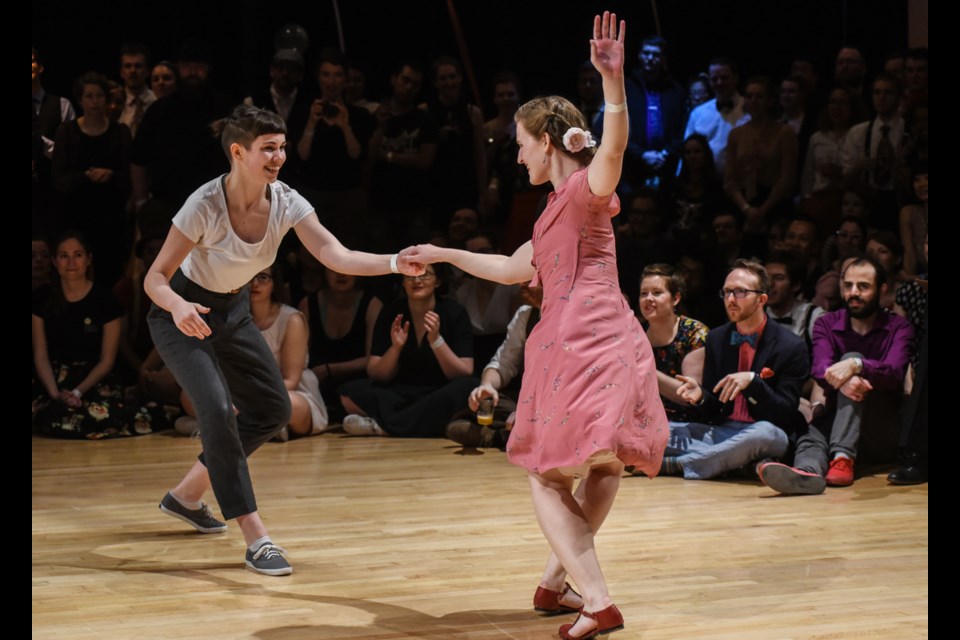While it takes discipline to stick with something for years, it’s passion that maintains excitement.
Eileen Jones is a long-time dancer, but her foremost role this past weekend was helping organize Lindy Bout X. Jones’s exhausting four-day schedule included unofficial brunches for lindy hoppers, panels about lindy hop, “Gentle Yoga for Lindy Bouters,” classes for lindy hop and, naturally, the competition — the Lindy Bout.
A team of keen volunteers turned Performance Works into a dance hall for the evening’s Cirque du Savoy, a name that tips its hat to Harlem’s famous ballroom when swing was king. The venue had already been decorated for the daytime events, but Saturday night is historically a special night for dances. So, streamers, new cardboard signs and a different colour scheme were added to the cloth-covered tables with balloons fancying up the room so it looked like the Hill Valley high school dance in Back to the Future. Â
As the crew dashed about, Jones — fondly called a “bossy” by this crowd — took a breather from the clipboard upstairs in the packed dressing room to describe what was about to take place on the floor as soon as doors opened at 8:30 p.m.
“Your heart is going to burst,” she said enthusiastically. “Yeah, it’s going to be really, really good. It’s so exciting. The energy at this event, the energy in this room — it’s palpable. There’s so much heart.”
Since lindy hop is improvisational by nature, Jones and others consider it to be a street dance. It was born in African American communities living in Harlem during the 1920s and ’30s and it grew alongside and within the jazz scene. It maintained its popularity during the swing era of the late 1930s and into the ’40s with its mishmash of different dances, including tap, jazz, breakaway and the Charleston.
Even its name is a mishmash of different stories. Some say lindy hop was named after Charles Lindbergh’s solo flight from New York to Paris in 1927. Others say the lindy hop existed in New York a decade before, albeit under a different name.
For Jones, lindy hop was the perfect fit during a time she was trying to figure out a way to fit dance into her university life 15 years ago. She tried jazz, ballet, contemporary and musical theatre while growing up, but it was lindy hop that took top billing. She joined the SFU Swing Club, and it just so happened one of her residence housemates was president of the club. This meant the perk of dances happened right in her living room. “I was so spoiled,” she said. “My formative months as a swing dancer were spent dancing every day with the better dancers in Vancouver.”
She caught the last gasp of the swing revival in Â鶹´«Ă˝Ół»in the early 2000s, attending the second-to-last swing dance hosted by Blue Lizard Productions at the Grandview Legion. Local lindy hoppers were a small but dedicated group in the following years, travelling to dance competitions around the country and the U.S. Fellow bossy Stephanie McKernan Taylor started Vancouver’s Lindy Bout 10 years ago after the Pacific Northwest Lindy Hop Championship died out in Seattle, according to Jones.
“Lindy Bout gets bigger and bigger every year. I feel like maybe three years ago we really turned a corner,” she said. “Lindy Bout is a beast. It’s a beast with a life of its own.”
The dance floor was full of swiveling bodies within five minutes of the doors opening. The hairstyles alone, which included Chelsea cuts, an Afro, victory rolls, pony tails and closely cropped, were enough to delightfully indicate Lindy Bout was open to all kinds.
Dancers warmed up to DJ Larry Low spinning the likes of Glenn Miller and Lionel Hampton before the house band, Josh Roberts and his Orchestra, kicked in and played for the casual and competitive dances, which included featherweight (medium tempo music) and haymaker
Jack & Jill finals (beginner competition), knockdown Jack & Jill (advanced dancers) and barnburner Jack & Jill (skilled) finals.
“Bringing together jazz music and jazz dancers, it allows both art forms to be practised in their complete capacity. They’re supposed to be together,” said Jones. “We have this whole community of musicians in Â鶹´«Ă˝Ół»who love playing for dancers, know how to play for dancers, are used to playing for dancers. There are even young musicians who cut their chops playing for dancers — they don’t know what the world would be like not to have dancers dancing to their music.”
She added, “The whole event is having that balance between the structured, formal competition and having the heart and joyous experience at the same time.”
Results from Lindy Bout X can be found at



